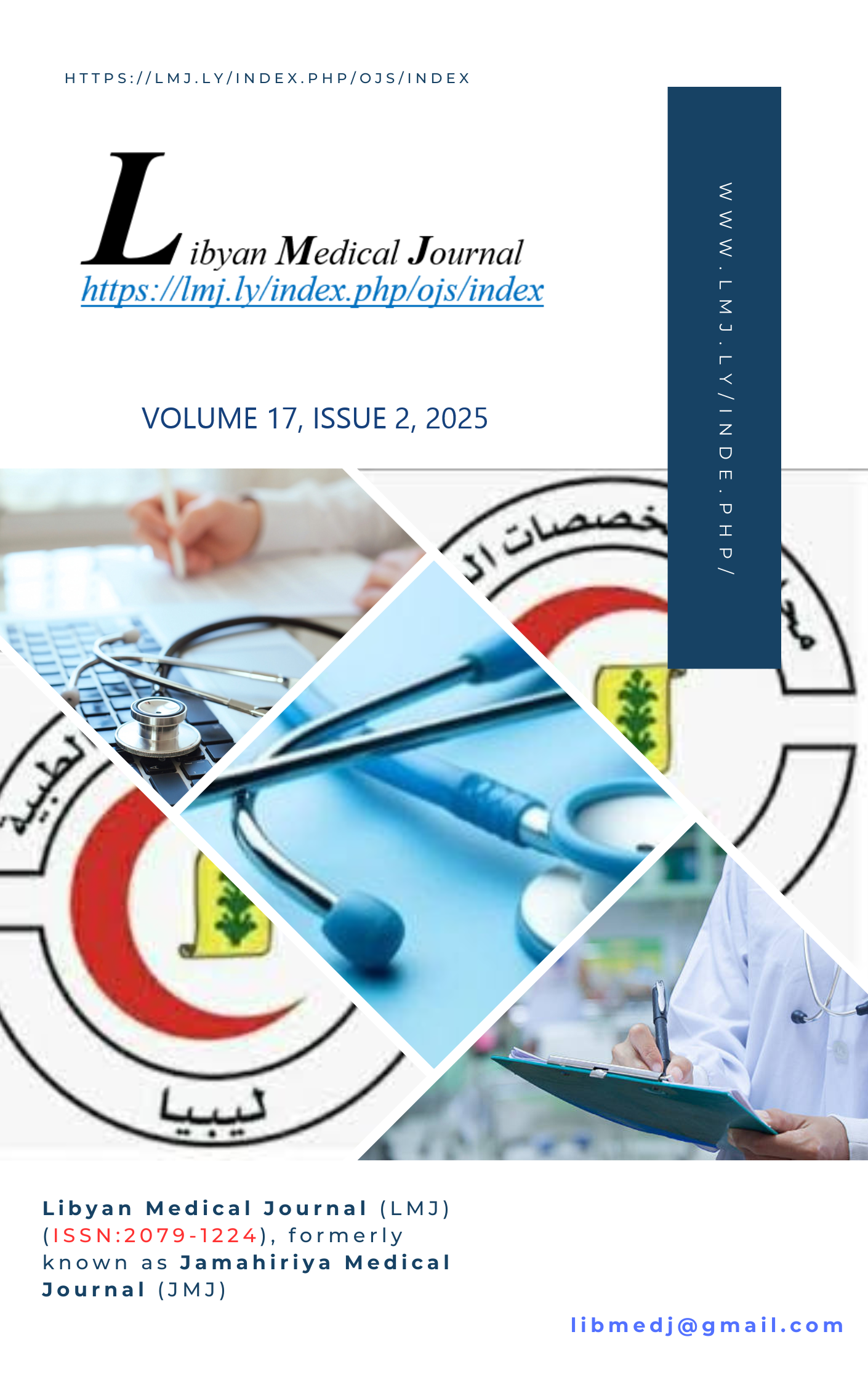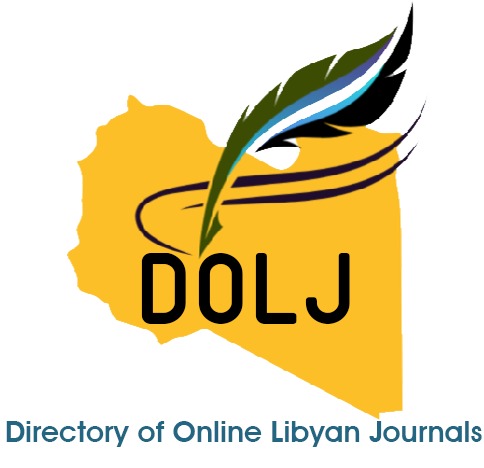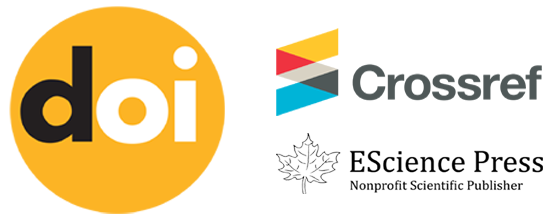The Impact of Metformin Therapy on Liver and Kidney Function in Type 2 Diabetic Patients: A Comparative Study Between Men and Women in Al-Bayda City
DOI:
https://doi.org/10.69667/lmj.2517206Keywords:
Metformin, Liver and Kidney Function, Diabetic Patients, Al-Bayda City.Abstract
This study examines the impact of metformin therapy on fasting blood sugar (FBS), renal function (urea and creatinine), and liver function (GOT, GPT, and ALP) in male and female type 2 diabetic patients. FBS levels, while numerically lower in females (106.8 ± 9.7 mg/dL) compared to males (119.7 ± 19 mg/dL), showed no statistically significant difference (p = 0.561), suggesting similar glycemic control across genders. Renal function assessment revealed significantly higher urea levels in males (37.40 ± 9.91 mg/dL) than in females (29.37 ± 5.02 mg/dL, p = 0.041), potentially indicating subtle gender-specific differences in renal function or protein metabolism. Similarly, creatinine levels were significantly higher in males (0.950 ± 0.158 mg/dL) compared to females (0.73 ± 0.1636 mg/dL, p = 0.007), suggesting the need for closer renal monitoring in male patients. Liver function parameters, including GOT, GPT, and ALP, revealed no statistically significant differences between genders. Although males exhibited higher mean values of GOT (40.0 ± 74.2 U/L) and GPT (31.0 ± 18.05 U/L) compared to females (20.3 ± 8.60 U/L and 18.37 ± 8.77 U/L, respectively), the differences did not reach significance (p = 0.415 and p = 0.062). ALP levels were nearly identical between genders (p = 0.696), indicating no gender-based variations in biliary or bone metabolism. In conclusion, metformin therapy demonstrates comparable efficacy and safety in managing glycemic and hepatic parameters in both genders. However, higher renal biomarkers in males highlight the importance of gender-specific monitoring. Further studies are recommended to explore these trends with larger cohorts.
References
Bailey CJ. Metformin: therapeutic profile in the treatment of type 2 diabetes. Diabetes Obes Metab. 2024;26:3–19.
Rines AK, Sharabi K, Tavares CD, Puigserver P. Targeting hepatic glucose metabolism in the treatment of type 2 diabetes. Nat Rev Drug Discov. 2016;15(11):786–804.
Srivastava RAK, Pinkosky SL, Filippov S, Hanselman JC, Cramer CT, Newton RS. AMP-activated protein kinase: an emerging drug target to regulate imbalances in lipid and carbohydrate metabolism to treat cardio-metabolic diseases. J Lipid Res. 2012;53(12):2490–2514.
Du Y, Zhu YJ, Zhou YX, Ding J, Liu JY. Metformin in therapeutic applications in human diseases: its mechanism of action and clinical study. Mol Biomed. 2022;3(1):41.
Plowman TJ, Christensen H, Aiges M, Fernandez E, Shah MH, Ramana KV. Anti-inflammatory potential of the anti-diabetic drug metformin in the prevention of inflammatory complications and infectious diseases including COVID-19: a narrative review. Int J Mol Sci. 2024;25(10):5190.
Zorov DB, Juhaszova M, Sollott SJ. Mitochondrial reactive oxygen species (ROS) and ROS-induced ROS release. Physiol Rev. 2014;94(3):909–950.
Wu Q, Zhao Y, Huang F. Metformin alleviates renal tubular injury in diabetic kidney disease by activating mitophagy and inhibiting ferroptosis via HIF-1α/MIOX signaling. J Pharm Anal. 2025;In press:101284.
Song A, Zhang C, Meng X. Mechanism and application of metformin in kidney diseases: an update. Biomed Pharmacother. 2021;138:111454.
Rena G, Hardie DG, Pearson ER. The mechanisms of action of metformin. Diabetologia. 2017;60(9):1577–1585.
Jalali M, Rahimlou M, Mahmoodi M, Moosavian SP, Symonds ME, Jalali R, et al. The effects of metformin administration on liver enzymes and body composition in non-diabetic patients with NAFLD and/or NASH: a systematic review and meta-analysis. Pharmacol Res. 2020;159:104799.
See KC. Metformin-associated lactic acidosis: a mini review of pathophysiology, diagnosis and management in critically ill patients. World J Diabetes. 2024;15(6):1178.
Al Salhen KS, Mahmoud AY. Determinants of abnormal kidney function tests in diabetes patient type 2 in Libya. Int J Sci Study. 2016;4(6):99–103.
Mauvais-Jarvis F. Sex differences in metabolic homeostasis, diabetes, and obesity. Biol Sex Differ. 2015;6:14.
Shufelt C, Braunstein GD. Testosterone and the metabolic syndrome. Curr Opin Endocrinol Diabetes Obes. 2009;16(3):220–226.
Altman DG. Practical statistics for medical research. London: Chapman & Hall; 1991.
Ko GJ, Rhee CM, Kalantar-Zadeh K, Joshi S. The effects of high-protein diets on kidney health and longevity. J Am Soc Nephrol. 2020;31(8):1667–1679.
Thongprayoon C, Cheungpasitporn W, Kashani K. Serum creatinine level, a surrogate of muscle mass, predicts mortality in critically ill patients. J Thorac Dis. 2016;8(5):E305.
Stevens PE, Ahmed SB, Carrero JJ, Foster B, Francis A, Hall RK, et al. KDIGO 2024 clinical practice guideline for the evaluation and management of chronic kidney disease. Kidney Int. 2024;105(4):S117–S314.
Ilias I, Rizzo M, Zabuliene L. Metformin: sex/gender differences in its uses and effects—narrative review. Medicina (Kaunas). 2022;58(3):430.
Regensteiner JG, Bauer TA, Huebschmann AG, Herlache L, Weinberger HD, Wolfel EE, et al. Sex differences in the effects of type 2 diabetes on exercise performance. Med Sci Sports Exerc. 2015;47(1):58.
Schini M, Vilaca T, Gossiel F, Salam S, Eastell R. Bone turnover markers: basic biology to clinical applications. Endocr Rev. 2023;44(3):417–473.
Shao N, Kuang HY, Hao M, Gao XY, Lin WJ, Zou W. Benefits of exenatide on obesity and NAFLD with elevated liver enzymes in patients with type 2 diabetes. Diabetes Metab Res Rev. 2014;30(6):521–529.
Abdelmola HJ, Khaled FA. Comparison of height, weight, vitamin D, calcium and parathyroid hormone between males and females at the Tobruk University. In: Sebha University Conference Proceedings. 2024. p. 281–290.











